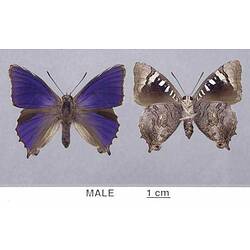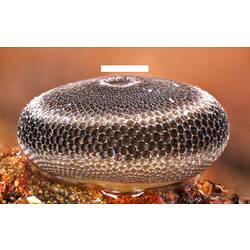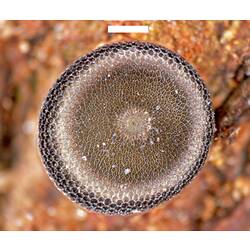General Description
Above: dark violet-purple with narrow black margins (males) or iridescent bluish-green basal areas of the wings and broad cream patch on the forewings (females). Below: grey, forewing basal area brownish-black with a series of pale iridescent bluish-white bars (males) females similar to males except forewing has a cream patch, hindwing markings more pronounced. Wingspan up to 5.5 cm.
Biology
Butterflies of this species are seldom seen close to the ground. Females fly near mistletoe in eucalyptus trees. Males can be seen combating rival males on hilltops. The larvae shelter near the base of eucalypt trees during the day and at night feed on mistletoe. They are always accompanied and protected by sugar ants during this journey to feed.
Distribution
From south-east Queensland to south-east South Australia. Uncommon in Victoria.
Habitat
Dry eucalypt woodland.
More Information
-
Animal Type
-
Animal SubType
-
Brief Id
Though both sexes have iridescent wings, male and female butterflies of this species look quite different.
-
Colours
Purple, Blue-green, Cream, Brown-black, White
-
Maximum Size
5.5 cm
-
Habitats
-
Diet
Nectar
-
Endemicity
-
Commercial
No
-
Conservation Statuses
CITES: Not listed, FFG Threatened List: Endangered, EPBC Act 1999: Not listed, IUCN Red List: Not listed
-
Taxon Name
-
Scientific Author
Hewitson, 1853
-
Common Name
Southern Purple Azure
-
Other Names
Purple Azure , Genoveva Azure
-
Kingdom
-
Phylum
-
Subphylum
-
Class
-
Order
-
Family
-
Genus
-
Species Name
genoveva




